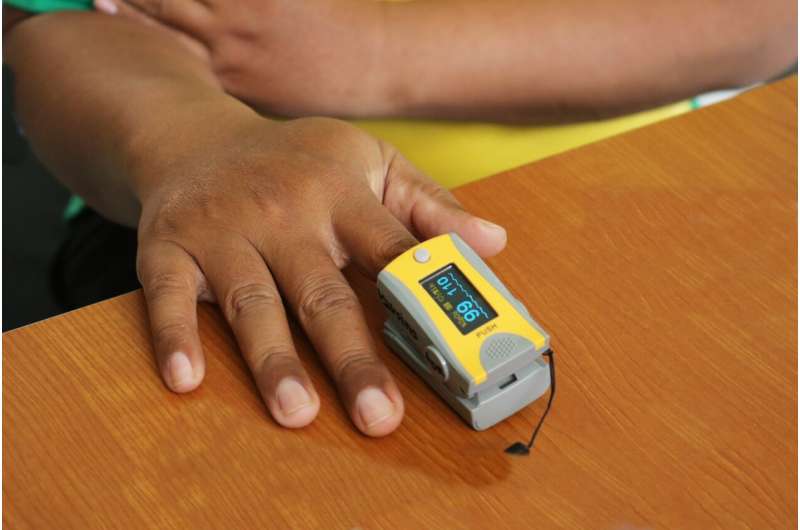This article has been reviewed according to Science X's editorial process and policies. Editors have highlighted the following attributes while ensuring the content's credibility:
fact-checked
peer-reviewed publication
trusted source
proofread
Pilot trial tracks measurement of blood oxygen levels managed by COVID-19 patients at home

A study conducted by UMC Utrecht during the pandemic showed that patients can easily perform oxygen measurements themselves at home, they felt safe doing so and the number of GP or hospital visits did not increase. The researchers believe that by enabling care close to home, patients experience more control and that it contributes to relieving caregivers and keeping health care affordable.
General practitioners (GPs) typically follow COVID-19 patients with moderate-to-severe symptoms closely to identify any deterioration in their condition in a timely manner. A key variable here is monitoring of blood oxygen levels. A sudden drop is an important sign of deterioration in the patient's condition. But in some patients, low oxygen levels do not go hand in hand with shortness of breath, so they do not feel it themselves but an oxygen measurement will detect it.
Identifying and treating these patients early can provide important health benefits. Especially when they have an underlying condition with a higher risk of an unfavorable disease course. The home measurement of oxygen levels by the patient can with this identification. UMC Utrecht therefore investigated the feasibility of home monitoring of COVID-19 patients by measuring oxygen saturation with a pulse oximeter (a medical measuring instrument that determines the oxygen level in the blood via a clip on a finger).
Well-controlled study
The study—published in the British Journal of General Practice—focused on people aged 40 years and older with moderate-to-severe symptoms of COVID-19, with cardiovascular disease or risk factors, and in whom the GP considered careful follow-up desirable. In a controlled study of the feasibility of home oxygen saturation monitoring, participants were divided by lot into two groups.
One half received a validated pulse oximeter on loan in addition to usual home health care, and the control group received usual home health care without a pulse oximeter. The first group was instructed to measure oxygen levels in their blood three times a day with the pulse oximeter. If saturation was less than 94%, they were to consult their GP.
The study showed that the pulse oximeter was used by the almost all patients according to the instructions. An oxygen saturation of less than 94% was measured a total of 52 times, in 10 patients. Six of them subsequently contacted their GP. Six weeks after the start of the study, there was no difference in recovery from COVID-19 infection between the intervention group and the control group. There was also no difference between the groups in terms of health care utilization such as GP contacts, hospital visits or hospitalization.
Lead researcher Dorien Zwart MD Ph.D. (Julius Center for Health Sciences and Primary Care, UMC Utrecht) says, "This study is the first to examine home monitoring of high-risk patients with moderate-to-severe corona symptoms in a GP setting. The study shows that home monitoring in this group with risk factors such as cardiovascular disease using a validated oxygen meter in daily practice is readily applicable. Patients willingly cooperated in the study and were well able to comply with instructions. In addition, they felt safe to take control and perform the measurements themselves. Also, they did not contact their GP more often in response to an oxygen measurement as compared to the control group."
Together with health care partners and patients, UMC Utrecht is developing (digital) initiatives that enable care closer to home. With this, care can be made even more personal and accessible: tailored to the individual patient as much as possible, and supported with apps where possible. Dorien says, "By enabling health care close to home, patients experience more personal control. And it also contributes to relieving the burden on our health care providers and keeping health care affordable."
More information: Karin Smit et al, Home monitoring by pulse oximetry of primary care patients with COVID-19: a pilot randomised controlled trial, British Journal of General Practice (2022). DOI: 10.3399/BJGP.2022.0224


















